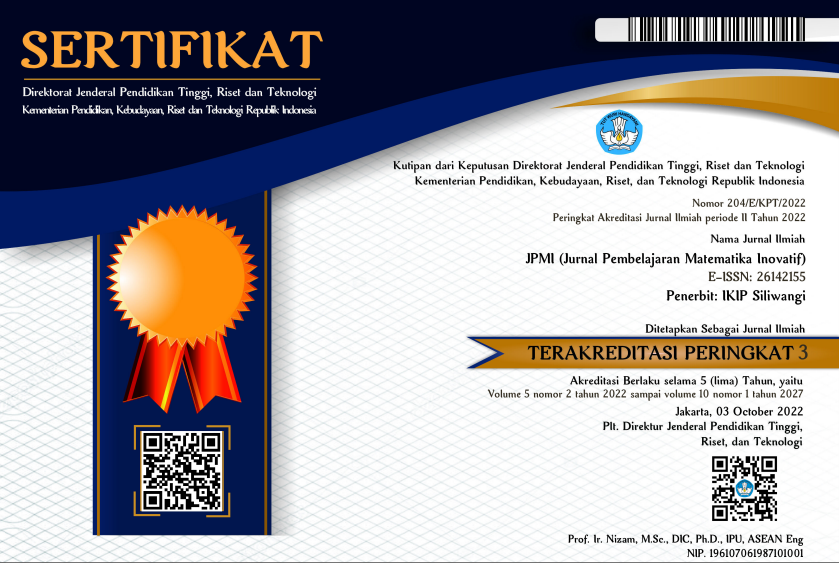ANALISIS KESULITAN SOAL MATERI ARITMETIKA SOSIAL PADA SISWA SMP
DOI:
https://doi.org/10.22460/jpmi.v4i6.p%25pKeywords:
Difficulty Analysis, Social Arithmetic, Online LearningAbstract
References
Covid-, P., Tasdik, R. N., & Amelia, R. (2021). Kendala Siswa SMK dalam Pembelajaran Daring Matematika di Situasi. 05(01), 510–521.
Dila, O. R., & Zanthy, L. S. (2020). Identifikasi Kesulitan Siswa Dalam Menyelesaikan Soal Aritmatika Sosial. Teorema: Teori Dan Riset Matematika, 5(1), 17. https://doi.org/10.25157/teorema.v5i1.3036
Fitri, N., Adirakarsiwi, A., & Utami, M. (2018). Analisis Kesulitan Siswa Smp Dalam Menyelesaikan Soal Cerita Aritmatika Sosial. Prosiding Seminar Nasional Matematika Dan Pendidikan Matematika, (1), 295.
Hadiprasetyo, K., Exacta, A. P., & Maharani, A. (2020). MATEMATIKA DENGAN PEMBELAJARAN DALAM JARINGAN ( DARING ) SELAMA MASA DARURAT COVID-19 PADA SISWA KELAS VIII SMP NEGERI 2 NGADIROJO TAHUN AJARAN 2019 / 2020. VI, 6–12.
Kurniawan, R. I., Nindiasari, H., & Setiani, Y. (2020). Analisis Kemampuan Pemecahan Masalah Matematis dengan Menggunakan Pembelajaran Daring. 1(2), 37–47.
Lestari, D. T., Rohaeti, E. E., & Senjayawati, E. (2019). Analisis Kesulitan Belajar Siswa SMP Kelas VIII dalam Menyelesaikan Soal Aritmatika Ditinjau dari Kemampuan Komunikasi Matematis. Journal On Education, 1(2), 440–444.
Munawaroh, N., Rohaeti, E. E., & Aripin, U. (2018). Analisis Kesalahan Siswa Berdasarkan Kategori Kesalahan Menurut Watson dalam Menyelesaikan Soal Komunikasi Matematis Siwa SMP. JPMI (Jurnal Pembelajaran Matematika Inovatif), 1(5), 993. https://doi.org/10.22460/jpmi.v1i5.p993-1004
Nopita, N., & Rosyana, T. (2021). MELALUI PEMBELAJARAN DARING. 4(4), 883–890. https://doi.org/10.22460/jpmi.v4i4.883-890
Putra, H. D., Setiawan, H., Nurdianti, D., Retta, I., & Desi, A. (2018). Kemampuan Pemahaman Matematis Siswa Smp Di Bandung Barat. Jurnal Penelitian Dan Pembelajaran Matematika, 11(1). https://doi.org/10.30870/jppm.v11i1.2981
Ruseffendi, E. T. (2006). Pengantar kepada membantu guru mengembangkan kompetensinya dalam pengajaran matematika untuk meningkatkan CBSA. Bandung: Tarsito.
Sari, A. R., & Aripin, U. (2018). Analisis Kesalahan Siswa Dalam Menyelesaikan Soal Cerita Bangun Datar Segiempat Ditinjau Dari Kemampuan Pemecahan Masalah Matematik Untuk Siswa Kelas Vii. JPMI (Jurnal Pembelajaran Matematika Inovatif), 1(6), 1135. https://doi.org/10.22460/jpmi.v1i6.p1135-1142
Utami, Y. P., Alan, D., Cahyono, D., & Indonesia, U. T. (2020). STUDY AT HOME : ANALISIS KESULITAN BELAJAR. 1(1), 20–26.
Waskitoningtyas, R. S. (2016). Analisis Kesulitan Belajar Matematika Siswa Kelas V Sekolah Dasar Kota Balikpapan Pada Materi Satuan Waktu Tahun Ajaran 2015/2016. JIPM (Jurnal Ilmiah Pendidikan Matematika), 5(1), 24. https://doi.org/10.25273/jipm.v5i1.852

















